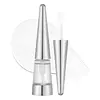What's inside
What's inside
 Key Ingredients
Key Ingredients

 Benefits
Benefits

 Concerns
Concerns

 Ingredients Side-by-side
Ingredients Side-by-side

Bis-Diglyceryl Polyacyladipate-2
EmollientPolybutene
Tridecyl Trimellitate
EmollientDiisostearyl Malate
EmollientHydrogenated Microcrystalline Wax
Emulsion StabilisingDipentaerythrityl Hexahydroxystearate/Hexastearate/Hexarosinate
Skin ConditioningSilica
AbrasiveGlyceryl Behenate/Eicosadioate
EmollientVanillyl Butyl Ether
MaskingSodium Hyaluronate
HumectantTocopheryl Acetate
AntioxidantHydrogenated Jojoba Oil
AbrasiveMica
Cosmetic ColorantEthyl Menthane Carboxamide
TonicEthylhexylglycerin
Skin ConditioningButylene Glycol
HumectantWater
Skin ConditioningVitis Vinifera Seed Extract
AntimicrobialPhenoxyethanol
PreservativeParfum
MaskingCI 77891
Cosmetic ColorantBis-Diglyceryl Polyacyladipate-2, Polybutene, Tridecyl Trimellitate, Diisostearyl Malate, Hydrogenated Microcrystalline Wax, Dipentaerythrityl Hexahydroxystearate/Hexastearate/Hexarosinate, Silica, Glyceryl Behenate/Eicosadioate, Vanillyl Butyl Ether, Sodium Hyaluronate, Tocopheryl Acetate, Hydrogenated Jojoba Oil, Mica, Ethyl Menthane Carboxamide, Ethylhexylglycerin, Butylene Glycol, Water, Vitis Vinifera Seed Extract, Phenoxyethanol, Parfum, CI 77891
Hydrogenated Polyisobutene
EmollientPolyglyceryl-2 Triisostearate
EmulsifyingDiisostearyl Malate
EmollientDimer Dilinoleyl Diisostearate
EmollientPhytosteryl/Isostearyl/Cetyl/Stearyl/Behenyl Dimer Dilinoleate
Skin ConditioningMenthyl Lactate
MaskingSorbitan Isostearate
EmulsifyingVanillyl Butyl Ether
MaskingSilica
AbrasiveTocopheryl Acetate
AntioxidantSimmondsia Chinensis Seed Oil
EmollientCaprylic/Capric Triglyceride
MaskingCentella Asiatica Extract
CleansingWater
Skin ConditioningButylene Glycol
Humectant1,2-Hexanediol
Skin ConditioningSodium Hyaluronate
HumectantAnemarrhena Asphodeloides Root Extract
Skin ConditioningMadecassic Acid
Skin ConditioningAsiatic Acid
Skin ConditioningMadecassoside
AntioxidantAsiaticoside
AntioxidantPropolis Extract
Skin ConditioningParfum
MaskingHydrogenated Polyisobutene, Polyglyceryl-2 Triisostearate, Diisostearyl Malate, Dimer Dilinoleyl Diisostearate, Phytosteryl/Isostearyl/Cetyl/Stearyl/Behenyl Dimer Dilinoleate, Menthyl Lactate, Sorbitan Isostearate, Vanillyl Butyl Ether, Silica, Tocopheryl Acetate, Simmondsia Chinensis Seed Oil, Caprylic/Capric Triglyceride, Centella Asiatica Extract, Water, Butylene Glycol, 1,2-Hexanediol, Sodium Hyaluronate, Anemarrhena Asphodeloides Root Extract, Madecassic Acid, Asiatic Acid, Madecassoside, Asiaticoside, Propolis Extract, Parfum
 Reviews
Reviews

Ingredients Explained
These ingredients are found in both products.
Ingredients higher up in an ingredient list are typically present in a larger amount.
Butylene Glycol (or BG) is used within cosmetic products for a few different reasons:
Overall, Butylene Glycol is a safe and well-rounded ingredient that works well with other ingredients.
Though this ingredient works well with most skin types, some people with sensitive skin may experience a reaction such as allergic rashes, closed comedones, or itchiness.
Learn more about Butylene GlycolDiisostearyl Malate is an emollient and most often used in lip products. It comes from isostearyl alcohol, a fatty acid, and malic acid, an AHA.
As an emollient, Diisostearyl Malate helps create a thin film on your skin to trap moisture in. This helps keep your skin soft and smooth.
Parfum is a catch-all term for an ingredient or more that is used to give a scent to products.
Also called "fragrance", this ingredient can be a blend of hundreds of chemicals or plant oils. This means every product with "fragrance" or "parfum" in the ingredients list is a different mixture.
For instance, Habanolide is a proprietary trade name for a specific aroma chemical. When used as a fragrance ingredient in cosmetics, most aroma chemicals fall under the broad labeling category of “FRAGRANCE” or “PARFUM” according to EU and US regulations.
The term 'parfum' or 'fragrance' is not regulated in many countries. In many cases, it is up to the brand to define this term.
For instance, many brands choose to label themselves as "fragrance-free" because they are not using synthetic fragrances. However, their products may still contain ingredients such as essential oils that are considered a fragrance by INCI standards.
One example is Calendula flower extract. Calendula is an essential oil that still imparts a scent or 'fragrance'.
Depending on the blend, the ingredients in the mixture can cause allergies and sensitivities on the skin. Some ingredients that are known EU allergens include linalool and citronellol.
Parfum can also be used to mask or cover an unpleasant scent.
The bottom line is: not all fragrances/parfum/ingredients are created equally. If you are worried about fragrances, we recommend taking a closer look at an ingredient. And of course, we always recommend speaking with a professional.
Learn more about ParfumSilica, also known as silicon dioxide, is a naturally occurring mineral. It is used as a fine, spherical, and porous powder in cosmetics.
Though it has exfoliant properties, the function of silica varies depending on the product.
The unique structure of silica enhances the spreadability and adds smoothness, making it a great texture enhancer.
It is also used as an active carrier, emulsifier, and mattifier due to its ability to absorb excess oil.
In some products, tiny microneedles called spicules are made from silica or hydrolyzed sponge. When you rub them in, they lightly polish away dead skin layers and enhance the penetration of active ingredients.
Learn more about SilicaSodium Hyaluronate is hyaluronic acid's salt form. It is commonly derived from the sodium salt of hyaluronic acid.
Like hyaluronic acid, it is great at holding water and acts as a humectant. This makes it a great skin hydrating ingredient.
Sodium Hyaluronate is naturally occurring in our bodies and is mostly found in eye fluid and joints.
These are some other common types of Hyaluronic Acid:
Learn more about Sodium HyaluronateTocopheryl Acetate is AKA Vitamin E. It is an antioxidant and protects your skin from free radicals. Free radicals damage the skin by breaking down collagen.
One study found using Tocopheryl Acetate with Vitamin C decreased the number of sunburned cells.
Tocopheryl Acetate is commonly found in both skincare and dietary supplements.
Learn more about Tocopheryl AcetateWe don't have a description for Vanillyl Butyl Ether yet.
Water. It's the most common cosmetic ingredient of all. You'll usually see it at the top of ingredient lists, meaning that it makes up the largest part of the product.
So why is it so popular? Water most often acts as a solvent - this means that it helps dissolve other ingredients into the formulation.
You'll also recognize water as that liquid we all need to stay alive. If you see this, drink a glass of water. Stay hydrated!
Learn more about Water